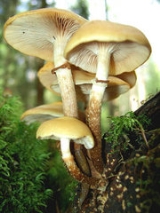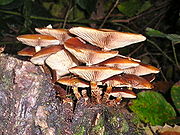
Kuehneromyces mutabilis
Encyclopedia
Kuehneromyces mutabilis (synonyms: Pholiota mutabilis), commonly known as the Sheathed Woodtuft, is an edible fungus which grows in clumps on tree stumps or other dead wood. A few other species have been described in the genus Kuehneromyces, but K. mutabilis is by far the most common and best known.
K. mutabilis cannot be recommended as an edible mushroom as there is a real possibility that it could be confused with the deadly poisonous Galerina marginata, even by people who are quite knowledgeable. Although a typical K. mutabilis is easily distinguished from a typical G. marginata by the "booted" stipe which is shaggy below the ring (see photos), this character is not reliable and G. marginata can also have scales. The main differences are:


Description
- The clustered shiny convex caps are 6-8 cm in diameter. They are very hygrophanousHygrophanousThe adjective hygrophanous refers to the color change of mushroom tissue as it loses or absorbs water, which causes the pileipellis to become more transparent when wet and opaque when dry....
; in a damp state they are shiny and greasy with a deep orange-brown colour towards the rim; often there is a disc of lighter (less sodden) flesh in the middle. In a dry state they are cinnamon-coloured. - The gills are initially light and later cinnamon brown, and are sometimes somewhat decurrent (running down the stem).
- The stipe is 8-10 cm long by about 0.5-1 cm in diameter with a ring which separates the bare, smooth light cinnamon upper part from the darker brown shaggily scaly lower part. This type of stem is sometimes described as "booted".
- This species always grows on wood, generally on stumps of broad-leaved trees (especially beech, birch and alder), and rarely on conifers.
- It is found from April to late October, and also in the remaining winter months where conditions are mild. It is often seen at times when there are few other fungi in evidence.
Range
Kuehneromyces mutabilis is found in Australia, Asia (in the Caucuses, Siberia, and Japan), North America, and Europe. In Europe, it can be found from Southern Europe to Iceland and Scandinavia.Edibility and possibility of confusion
The caps of this mushroom can be fried or used for flavouring in sauces and soups (the stems being considered too tough to eat).K. mutabilis cannot be recommended as an edible mushroom as there is a real possibility that it could be confused with the deadly poisonous Galerina marginata, even by people who are quite knowledgeable. Although a typical K. mutabilis is easily distinguished from a typical G. marginata by the "booted" stipe which is shaggy below the ring (see photos), this character is not reliable and G. marginata can also have scales. The main differences are:


- while they are both hygrophanous, K. mutabilis dries from the centre outwards (so having a lighter colour in the centre) and G. marginata dries from the edge inwards,
- the stem below the ring is scaly below the ring in K. mutabilis, but normally fibrously silky in G. marginata,
- K. mutabilis has a pleasant mushroom smell and mild taste, whereas G. marginata tastes and smells mealy.
External links
- Pholiota mutabilis, from Smith AHAlexander H. SmithAlexander Hanchett Smith was an American mycologist known for his extensive contributions to the taxonomy and phylogeny of the higher fungi, especially the agarics.-Early life:...
& Hesler LR. (1968). The North American Species of Pholiota. (Archived at Mykoweb.com.) - Pholiota mutabilis by Michael Kuo, MushroomExpert.Com, November, 2007.
- Kuehneromyces mutabilis by Roger Philips, RogersMushrooms (website).
- “Kuehneromyces mutabilis” by Robert Sasata, Healing-Mushrooms.net, February, 2008.

